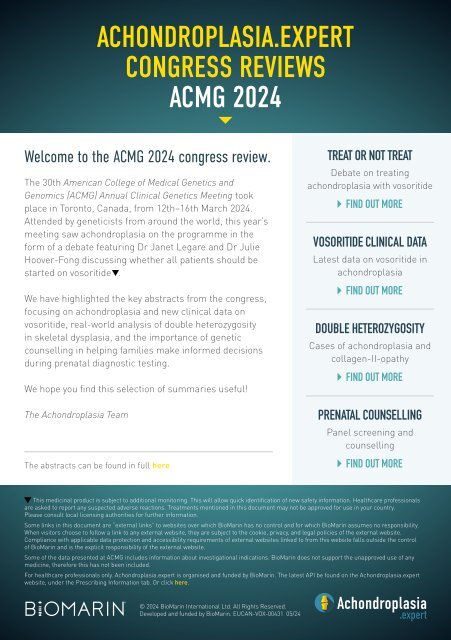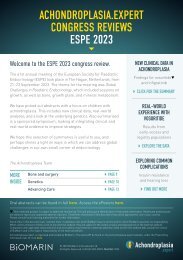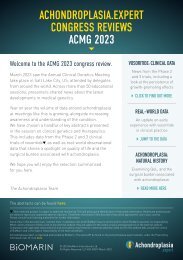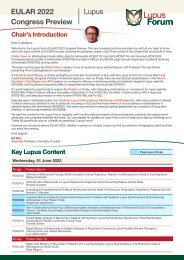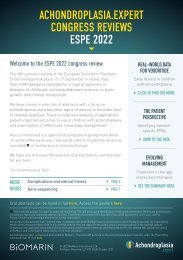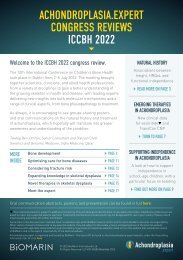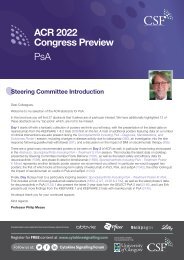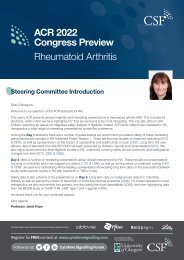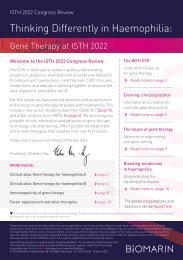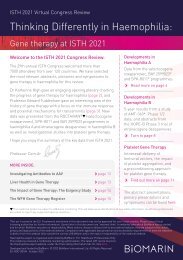ACMG Congress Review 24
The 30th American College of Medical Genetics and Genomics (ACMG) Annual Clinical Genetics Meeting took place in Toronto, Canada, from 12th–16th March 2024. Attended by geneticists from around the world, this year’s meeting saw achondroplasia on the programme in the form of a debate featuring Dr Janet Legare and Dr Julie Hoover-Fong discussing whether all patients should be started on vosoritide▼.
The 30th American College of Medical Genetics and Genomics (ACMG) Annual Clinical Genetics Meeting took place in Toronto, Canada, from 12th–16th March 2024. Attended by geneticists from around the world, this year’s meeting saw achondroplasia on the programme in the form of a debate featuring Dr Janet Legare and Dr Julie Hoover-Fong discussing whether all patients should be started on vosoritide▼.
You also want an ePaper? Increase the reach of your titles
YUMPU automatically turns print PDFs into web optimized ePapers that Google loves.
ACHONDROPLASIA.EXPERT<br />
CONGRESS REVIEWS<br />
<strong>ACMG</strong> 20<strong>24</strong><br />
Welcome to the <strong>ACMG</strong> 20<strong>24</strong> congress review.<br />
The 30th American College of Medical Genetics and<br />
Genomics (<strong>ACMG</strong>) Annual Clinical Genetics Meeting took<br />
place in Toronto, Canada, from 12th–16th March 20<strong>24</strong>.<br />
Attended by geneticists from around the world, this year’s<br />
meeting saw achondroplasia on the programme in the<br />
form of a debate featuring Dr Janet Legare and Dr Julie<br />
Hoover-Fong discussing whether all patients should be<br />
started on vosoritide .<br />
We have highlighted the key abstracts from the congress,<br />
focusing on achondroplasia and new clinical data on<br />
vosoritide, real-world analysis of double heterozygosity<br />
in skeletal dysplasia, and the importance of genetic<br />
counselling in helping families make informed decisions<br />
during prenatal diagnostic testing.<br />
We hope you find this selection of summaries useful!<br />
The Achondroplasia Team<br />
The abstracts can be found in full here.<br />
TREAT OR NOT TREAT<br />
Debate on treating<br />
achondroplasia with vosoritide<br />
FIND OUT MORE<br />
VOSORITIDE CLINICAL DATA<br />
Latest data on vosoritide in<br />
achondroplasia<br />
FIND OUT MORE<br />
DOUBLE HETEROZYGOSITY<br />
Cases of achondroplasia and<br />
collagen-II-opathy<br />
FIND OUT MORE<br />
PRENATAL COUNSELLING<br />
Panel screening and<br />
counselling<br />
FIND OUT MORE<br />
This medicinal product is subject to additional monitoring. This will allow quick identification of new safety information. Healthcare professionals<br />
are asked to report any suspected adverse reactions. Treatments mentioned in this document may not be approved for use in your country.<br />
Please consult local licensing authorities for further information.<br />
Some links in this document are “external links” to websites over which BioMarin has no control and for which BioMarin assumes no responsibility.<br />
When visitors choose to follow a link to any external website, they are subject to the cookie, privacy, and legal policies of the external website.<br />
Compliance with applicable data protection and accessibility requirements of external websites linked to from this website falls outside the control<br />
of BioMarin and is the explicit responsibility of the external website.<br />
Some of the data presented at <strong>ACMG</strong> includes information about investigational indications. BioMarin does not support the unapproved use of any<br />
medicine, therefore this has not been included.<br />
For healthcare professionals only. Achondroplasia.expert is organised and funded by BioMarin. The latest API be found on the Achondroplasia.expert<br />
website, under the Prescribing Information tab. Or click here.<br />
© 20<strong>24</strong> BioMarin International Ltd. All Rights Reserved.<br />
Developed and funded by BioMarin. EUCAN-VOX-00431 05/<strong>24</strong><br />
1
Achondroplasia.expert <strong>Congress</strong> <strong>Review</strong>s: <strong>ACMG</strong> 20<strong>24</strong><br />
TREAT OR NOT TREAT<br />
A mock debate on whether or not to use vosoritide to treat individuals with<br />
achondroplasia. Janet Legare played the role of the affirmative, arguing that<br />
every child should be treated, and Julie Hoover-Fong was playing devil's<br />
advocate, and argued “just say no: all children should not be treated”.<br />
Janet Legare opened by advocating for<br />
vosoritide treatment, emphasising that it is<br />
an effective and well tolerated treatment that<br />
may improve medical sequelae associated<br />
with achondroplasia. Vosoritide has shown<br />
that it can increase annualised growth velocity<br />
(AGV). Janet highlighted that early treatment,<br />
before growth plate fusion in the spine, is<br />
crucial to maximise the benefits of vosoritide,<br />
such as reducing spinal stenosis. While<br />
height can be used as a metric to measure<br />
the efficacy of vosoritide, improved health is<br />
the ultimate goal. Legare also stressed that<br />
vosoritide has an extremely specific mode<br />
of action, targeting the inhibitory pathway of<br />
FGFR3, and has very few side effects.<br />
Julie Hoover-Fong played devil's advocate<br />
during the debate, arguing against the use<br />
of vosoritide, proposing that there is in fact<br />
nothing to treat, and that suggesting otherwise<br />
may negatively impact the culture of dwarf<br />
pride, self-help, and support groups. She also<br />
agued that there are misconceptions about<br />
the potential effects of treatment, with some<br />
patients not responding as well as others<br />
and not enough data on co-morbidities being<br />
available. Hoover-Fong also proposed that a<br />
better alternative may be available in future, as<br />
the daily injections of vosoritide can be difficult<br />
for parents to administer to their children<br />
and an oral medication would be preferred.<br />
Legare responded by stating that the use<br />
of medication does not detract from having<br />
achondroplasia, or the need for regular care<br />
of the associated health issues. She also<br />
reiterated that most data shows that vosoritide<br />
is well tolerated and effective for increasing<br />
AGV. However, Janet suggested that an<br />
improvement in FMS score is the main goal,<br />
not increased height, and that if vosoritide can<br />
reduce medical sequelae, even just for FMS<br />
then it will be worth it for young patients.<br />
Julie countered that height should be<br />
considered as height is part of our identity.<br />
There is also no data yet available on whether<br />
vosoritide treatment results in any change<br />
in the spine or FMS. It’s also not possible<br />
to discuss treatment with a child at the age<br />
before the closure of their growth plates;<br />
they may not have wanted to be treated with<br />
vosoritide. Hoover-Fong also reiterated that<br />
oral medication may be an option in future.<br />
Janet closed with a reminder that time is of<br />
the essence, and vosoritide is not an attempt to<br />
treat a disease, but a condition. She concedes<br />
that due to the need for vosoritide treatment to<br />
be initiated at a young age, we won’t know the<br />
full impact for decades, but gives a reminder<br />
that vosoritide is the only approved medication<br />
to treat growth in achondroplasia. People who<br />
have been treated with vosoritide have been<br />
followed for overall care and psychological<br />
assessment of families and patients are<br />
showing an increase in empowerment. Support<br />
groups are also becoming more welcoming to<br />
patients receiving achondroplasia treatment,<br />
and continued support from groups like the<br />
Little People of America can be key to whether<br />
patients continue to pursue treatment. Legare<br />
finished with the reminder that height may be<br />
the metric, but better health is the goal.<br />
Julie stated that many patients may think<br />
that if they start treatment, they don’t<br />
need to continue with their health routine<br />
surveillance or management, which could<br />
have some long-term consequences.<br />
While it is true that the Little People of<br />
America are changing their stance on<br />
vosoritide, they aren’t “rolling out the red<br />
carpet” for it. There is also the view that<br />
a person with achondroplasia is still an<br />
important individual and that they may feel<br />
their identity is negatively impacted.<br />
The debate concluded with a poll for<br />
the audience: How confident are you in<br />
recommending treatment for all patients?<br />
The poll resulted in 70% for and 30% against<br />
vosoritide treatment in all patients.<br />
NEW VOSORITIDE DATA IN ACHONDROPLASIA<br />
Vosoritide is indicated for the treatment of achondroplasia in patients<br />
4 months of age and older whose epiphyses are not closed. 1<br />
Hoover-Fong et al. presented data on<br />
vosoritide’s prolonged effect in an ongoing<br />
52-week Phase 2 open label extension (OLE)<br />
study (BMN 111-205) conducted in children<br />
aged 5–14 years with achondroplasia (ACH).<br />
Safety and efficacy findings were reported<br />
after a mean of 80.95 months (SD 17.73,<br />
max. 106.7), representing the longest<br />
clinical experience with vosoritide to date.<br />
Comparative analysis was conducted for all<br />
participants who reached 7 years follow up<br />
(N=17), and cross-sectional analysis was<br />
performed with untreated subjects who<br />
were matched to each of the subjects in the<br />
vosoritide arm at baseline (N=390) and at the<br />
7-year timepoint (N=173) by age and sex. The<br />
primary endpoint was safety and tolerability<br />
of vosoritide (15 or 30 μg/kg/day). 2<br />
Vosoritide demonstrated a well-tolerated<br />
safety profile, with no evidence of accelerated<br />
skeletal maturation or serious events over<br />
7 years of treatment. Injection site reactions<br />
were the most common adverse event<br />
(3.3%) and no serious adverse events led<br />
to discontinuation of vosoritide and were<br />
generally attributed to underlying ACH. 2<br />
After 7 years, children who underwent<br />
treatment with vosoritide (15 µg/kg or 30 µg/kg)<br />
exhibited an additional height gain of 11.03 cm<br />
in comparison with untreated age and<br />
sex-matched ACH controls. Mean differences<br />
in AGV between treated versus untreated<br />
participants across integer age groups<br />
from 6 to 16 years was 1.63 (0.57) cm/year<br />
for boys and 1.33 (0.58) cm/year for girls.<br />
2 3
Achondroplasia.expert <strong>Congress</strong> <strong>Review</strong>s: <strong>ACMG</strong> 20<strong>24</strong><br />
At Month 84 (n=15), change from baseline<br />
in height z-score was +1.67 (0.67) relative<br />
to an untreated ACH population (CLARITY 3 )<br />
and change in upper:lower body ratio<br />
was -0.21 (0.12).<br />
Mean AGVs of treated children were<br />
comparable to that of average stature<br />
children prior to puberty and were maintained<br />
over a longer duration. Vosoritide’s durability,<br />
growth-promoting effects and well tolerated<br />
safety profile were maintained over an<br />
extended period of 7 years, demonstrating<br />
its potential to offer significant therapeutic<br />
benefit to individuals with ACH. 2 [P144]<br />
Savarirayan et al. presented results from a<br />
Phase 2 extension study (111-208), exploring<br />
Mean 12-month interval AGV in children treated with vosoritide is higher compared to age-matched untreated children<br />
Mean (SD) Annualized<br />
Growth Velocity (cm/yr)<br />
11<br />
10<br />
9<br />
8<br />
7<br />
6<br />
5<br />
4<br />
3<br />
2<br />
1<br />
0<br />
-1<br />
-2<br />
ACH treated:<br />
ACH untreated:<br />
Average stature:<br />
Mean (SD) Annualized<br />
Growth Velocity (cm/yr)<br />
11<br />
10<br />
9<br />
8<br />
7<br />
6<br />
5<br />
4<br />
3<br />
2<br />
1<br />
0<br />
-1<br />
-2<br />
ACH treated:<br />
ACH untreated:<br />
Average stature:<br />
Error bars = SD<br />
Girls<br />
6 7 8 9 10 11 12 13 14 15 16 17 18<br />
1<br />
102<br />
43<br />
4<br />
82<br />
107<br />
Error bars = SD<br />
10<br />
77<br />
90<br />
14<br />
72<br />
111<br />
ACH untreated reference derived from CLARITY 3<br />
Average stature reference is non-African American data from Kelly A et al. J Clin Endocrinol Metab. 2014.<br />
15<br />
61<br />
140<br />
Age (years)<br />
14<br />
48<br />
161<br />
14<br />
37<br />
192<br />
14<br />
39<br />
187<br />
11<br />
33<br />
163<br />
5<br />
26<br />
171<br />
1<br />
17<br />
192<br />
ACH treated<br />
ACH untreated<br />
Average stature<br />
6 7 8 9 10 11 12 13 14 15 16 17 18<br />
1<br />
117<br />
37<br />
4<br />
88<br />
105<br />
7<br />
79<br />
85<br />
9<br />
62<br />
100<br />
9<br />
62<br />
116<br />
Age (years)<br />
11<br />
52<br />
144<br />
Boys<br />
12<br />
45<br />
186<br />
11<br />
35<br />
150<br />
7<br />
<strong>24</strong><br />
151<br />
6<br />
20<br />
168<br />
2<br />
21<br />
163<br />
0<br />
13<br />
154<br />
ACH treated<br />
0<br />
6<br />
0<br />
ACH untreated<br />
Average stature<br />
2<br />
19<br />
163<br />
0<br />
8<br />
105<br />
Hoover-Fong J, et al. [P144]<br />
vosoritide’s effect in young children with<br />
achondroplasia aged 3 months– 1 SDS after 4 years<br />
Children < 2 years at start of treatment<br />
1 year<br />
Study 111-206 (FAS randomized)<br />
Study 111-206 (FAS)<br />
Study 111-206 (FAS randomized)<br />
Study 111-206/111-208<br />
Study 111-206/111-208<br />
Study 111-206/111-208<br />
Study 111-206/111-208<br />
2 year<br />
Study 111-206/111-208<br />
Study 111-206/111-208<br />
Study 111-206/111-208<br />
Study 111-206/111-208<br />
3 year<br />
Study 111-206/111-208<br />
Study 111-206/111-208<br />
Study 111-206/111-208<br />
Consistent and sustained treatment effect with mean height Z-score gain > 0.79 SDS over 3 years<br />
0.33<br />
0.29<br />
0.48<br />
0.45<br />
0.40<br />
0.45<br />
0.<strong>24</strong><br />
0.59<br />
0.58<br />
0.57<br />
0.33<br />
0.86<br />
0.80<br />
0.73<br />
0.55<br />
1.29<br />
1.42<br />
1.10<br />
Timepoint Studies Comparator Number of subjects Treatment<br />
Vosoritide Comparator difference<br />
AchNH reference derived from CLARITY 3<br />
111-206 placebo<br />
111-206 placebo<br />
AchNH longitudinal<br />
AchNH longitudinal<br />
AchNH cross-sectional<br />
Obs/Pbo longitudinal<br />
Obs/Pbo cross-sectional<br />
AchNH longitudinal<br />
AchNH cross-sectional<br />
Obs/Pbo longitudinal<br />
Obs/Pbo cross-sectional<br />
AchNH longitudinal<br />
AchNH cross-sectional<br />
Obs/Pbo cross-sectional<br />
17<br />
<strong>24</strong><br />
16<br />
32<br />
32<br />
32<br />
28<br />
25<br />
25<br />
25<br />
25<br />
14<br />
14<br />
14<br />
16<br />
16<br />
216<br />
287<br />
788/716<br />
31<br />
49/56<br />
223<br />
767/638<br />
20<br />
55/64<br />
150<br />
715/509<br />
61/85<br />
0.26<br />
0.35<br />
0.53<br />
0.50<br />
0.53<br />
0.53<br />
0.74<br />
0.48<br />
0.63<br />
0.74<br />
0.74<br />
0.86<br />
0.79<br />
0.98<br />
Treatment difference (95% Cl)<br />
Vosoritide minus comparator<br />
-2 -1 0 1 2<br />
Comparator better<br />
-2<br />
Height Z-score<br />
Vosoritide better<br />
Treatment difference (95% Cl)<br />
Vosoritide minus comparator<br />
Comparator better<br />
-1 0 1 2<br />
Height Z-score<br />
Vosoritide better<br />
Savarirayan R, et al. [P131]<br />
4 5
Achondroplasia.expert <strong>Congress</strong> <strong>Review</strong>s: <strong>ACMG</strong> 20<strong>24</strong><br />
Participants were grouped based on age at the<br />
start of vosoritide treatment: children aged<br />
≥2 years at the start of vosoritide treatment<br />
(4 years follow-up) or children aged 2-year group saw 0.79–0.98 SDS after 3 years.<br />
Mean height gains increased by 3.0– 4.12 in<br />
the ≥2-year cohort compared with 3.45–3.87<br />
in the
Achondroplasia.expert <strong>Congress</strong> <strong>Review</strong>s: <strong>ACMG</strong> 20<strong>24</strong><br />
Savarirayan et al. showed further data<br />
from a Phase 3 OLE trial (111-301/302)<br />
demonstrating efficacy of vosoritide in<br />
promoting growth in children with ACH<br />
compared with placebo (15 μg/kg/day of<br />
vosoritide). 7 In an exploration of the longterm<br />
effects of vosoritide on health-related<br />
quality of life (HRQoL), this study utilised<br />
the Quality of Life in Short Stature Youth<br />
(QoLISSY) questionnaire in children who<br />
participated in the OLE (n=119) compared<br />
with an untreated group (n=150). 8<br />
Participants and their caregivers completed<br />
the QoLISSY questionnaire at baseline and<br />
every 6 months thereafter, focusing on<br />
various domains such as physical, social,<br />
and emotional.<br />
After 3 years, mean (SD) change in the<br />
physical domain score was 6.0 (19.4) for<br />
caregiver reported (n=99) and 6.3 (20.2)<br />
for self-reported (n=60). Changes to other<br />
domains were less pronounced after 3 years<br />
(change in total score was 3.3 (15.5) for<br />
caregivers and 5.4 (17.7) for self-reported).<br />
Greater improvement in the physical<br />
domain was noticed in children with ≥1 SD<br />
increase in ACH height z-score where mean<br />
changes in the physical domain scores were<br />
11.4 (19.5) for caregiver-reported (n=38) and<br />
8.5 (21.8) for self-reported (n=28). 8<br />
The study found that after 3 years of<br />
treatment, there was a notable improvement<br />
in QoLISSY total scores, with even greater<br />
enhancements observed in children who<br />
showed significant growth improvements.<br />
These findings suggest that vosoritide<br />
improves HRQoL among children with ACH,<br />
particularly for the physical domain score. 8<br />
[P141]<br />
Mean change from baseline in caregiver reported QoLISSY scores at Year 3 in the treated population 8<br />
Mean change from baseline in self-reported QoLISSY scores at Year 3 in the treated population 8<br />
16<br />
Overall<br />
16<br />
Overall<br />
14<br />
12<br />
Change in ACH Z-score
Achondroplasia.expert <strong>Congress</strong> <strong>Review</strong>s: <strong>ACMG</strong> 20<strong>24</strong><br />
DOUBLE HETEROZYGOSITY IN<br />
SKELETAL DYSPLASIA<br />
Double heterozygosity occurs when individuals inherit two distinct dominant<br />
genetic conditions within the skeletal dysplasia spectrum. Historically,<br />
cases of double heterozygosity have been associated with severe life-limiting<br />
or fatal outcomes. However, advancements in medical technology have<br />
challenged the traditional prognosis associated with this condition. 9<br />
Schelhaas et al. aimed to address the unique<br />
phenomenon of double heterozygosity in<br />
two children with molecularly confirmed<br />
ACH and collagen-II-opathy, now aged 2 and<br />
6 years. The younger child has undergone<br />
neurosurgical management of foramen<br />
magnum stenosis, and an elevated risk of<br />
hydrocephalus has been observed in the<br />
first 2–3 years of life in ACH. 9<br />
Both children have undergone extensive<br />
medical interventions, including tracheostomy,<br />
ventilator support, and neurosurgical<br />
procedures to manage complications such<br />
as tracheomalacia, spinal cord compression,<br />
cervical instability, and hydrocephalus.<br />
Despite the lack of existing literature on the<br />
medical management of individuals with dual<br />
dysplasia diagnoses, these cases underscore<br />
the importance of multidisciplinary care<br />
involving genetics, neurosurgery, orthopaedics,<br />
pulmonology, otolaryngology, craniofacial<br />
plastic surgery, and speech therapy. 9<br />
The successful management of these cases<br />
challenges the historically poor prognosis<br />
associated with double heterozygosity.<br />
The children have surpassed previous<br />
expectations and are thriving under<br />
specialised medical care. This study<br />
highlights the necessity of updated prenatal<br />
counselling protocols that incorporate the<br />
possibility of life-sustaining interventions<br />
and the value of specialised care from<br />
experienced providers in managing rare<br />
dysplasia diagnoses. By acknowledging<br />
the potential for positive outcomes and<br />
providing comprehensive support,<br />
healthcare professionals can better<br />
guide parents facing similar diagnoses,<br />
offering hope and improving the quality<br />
of care for affected individuals. 9 [P814]<br />
PRENATAL COUNSELLING IN<br />
SKELETAL DYSPLASIA<br />
Skeletal dysplasia encompasses a spectrum of congenital conditions<br />
affecting bone and cartilage, stemming from genetic variations. Estimated<br />
incidence is 1 in every 5000 newborns and 5 in every 1000 pregnancies.<br />
Identification of prenatal skeletal dysplasia holds critical importance in<br />
facilitating family planning options, tailored perinatal care, delivery at<br />
specialised hospitals, psychological support, and informed decision-making<br />
involving termination of pregnancy. The effective management of prenatal<br />
testing via genetic counsellors or medical geneticists are pivotal in aiding<br />
families to comprehend outcomes and make informed decisions. 10<br />
Shaw et al. presents a retrospective analysis<br />
of prenatal skeletal dysplasia panel cases<br />
conducted at a commercial laboratory between<br />
October 10, 2018, and August 2, 2023. The<br />
panel included 177 genes with associations<br />
to a range of skeletal dysplasia phenotypes. 10<br />
Genes with pathogenic and likely pathogenic variants identified 10<br />
Number of Cases<br />
25<br />
20<br />
15<br />
10<br />
142 skeletal dysplasia panels were completed<br />
on prenatal specimens. 69 cases were<br />
positive, yielding a 48.2% positivity rate for<br />
diagnostic results consistent with skeletal<br />
dysplasia; 51 of these cases were pathogenic<br />
and 18 were likely pathogenic. A total of 19<br />
P # of Cases<br />
LP # of Cases<br />
5<br />
0<br />
ALPL<br />
COL11A1<br />
COL1A1<br />
COL1A2<br />
COL2A1<br />
DYNC2H1<br />
EBP<br />
EVC2<br />
FGFR3<br />
LIFR<br />
P3H1<br />
ROR2<br />
RUNX2<br />
SHOX<br />
SLC26A2<br />
TRIP11<br />
COL9A3<br />
IHH<br />
WNT7A<br />
Genes with Pathogenic and Likely Pathogenic Variants<br />
Shaw J, et al. [P779]<br />
10 11
Achondroplasia.expert <strong>Congress</strong> <strong>Review</strong>s: <strong>ACMG</strong> 20<strong>24</strong><br />
unique diagnostic genes were discovered,<br />
eight of which are known to lead to lethal<br />
forms of skeletal dysplasia (COL1A1, COL1A2,<br />
EBP, LIFR, FGFR3, SLC26A2, TRIP11, and<br />
DLL3). These findings underscore the<br />
necessity of offering prenatal testing options<br />
when abnormal ultrasound findings are<br />
present, as many skeletal dysplasia cases<br />
are hypothesised to be lethal either in the<br />
prenatal or perinatal period. However,<br />
termination of affected pregnancies,<br />
while an option for some individuals,<br />
may present logistical challenges depending<br />
on gestational age and legal considerations. 10<br />
Overall, the findings support the need for<br />
comprehensive prenatal care and informed<br />
decision-making processes for families<br />
affected by skeletal dysplasia. By providing<br />
access to prenatal testing and genetic<br />
counselling, healthcare professionals can<br />
better support patients and promote optimal<br />
outcomes for both mothers and newborns. 10<br />
[P779]<br />
LIST OF ABBREVIATIONS<br />
ACH – achondroplasia<br />
AGV – annualised growth velocity<br />
FGFR3 – fibroblast growth factor receptor 3<br />
HRQoL – health-related quality of life<br />
OLE – open label extension<br />
QoLISSY – Quality of Life in Short Stature Youth<br />
REFERENCES<br />
1. Vosoritide SmPC. https://www.ema.europa.eu/<br />
en/documents/product-information/voxzogoepar-product-information_en.pdf<br />
(Accessed 12 April 20<strong>24</strong>)<br />
2. Hoover-Fong J, et al. Gen in Med Open.<br />
20<strong>24</strong>;2(suppl.1):101041.<br />
3. Hoover-Fong J, et al. Orphanet J Rare Dis.<br />
2021:16(1):522.<br />
4. Savarirayan R, et al. Gen in Med Open.<br />
20<strong>24</strong>;2(suppl.1):101028.<br />
5. Savarirayan R, et al. The Lancet.<br />
2020;396(10252):684–92.<br />
6. Savarirayan R, et al. Gen in Med. 2021<br />
Dec;23(12):<strong>24</strong>43–7.<br />
7. Savarirayan R, et al. Gen in Med Open.<br />
20<strong>24</strong>;2(suppl.1):101036.<br />
8. Savarirayan R, et al. Gen in Med Open.<br />
20<strong>24</strong>;2(suppl.1):101038.<br />
9. Schelhaas A, et al. Gen in Med Open.<br />
20<strong>24</strong>;2(suppl.1):101722.<br />
10. Shaw J, et al. Gen in Med Open.<br />
20<strong>24</strong>;2(suppl.1):101687<br />
12


